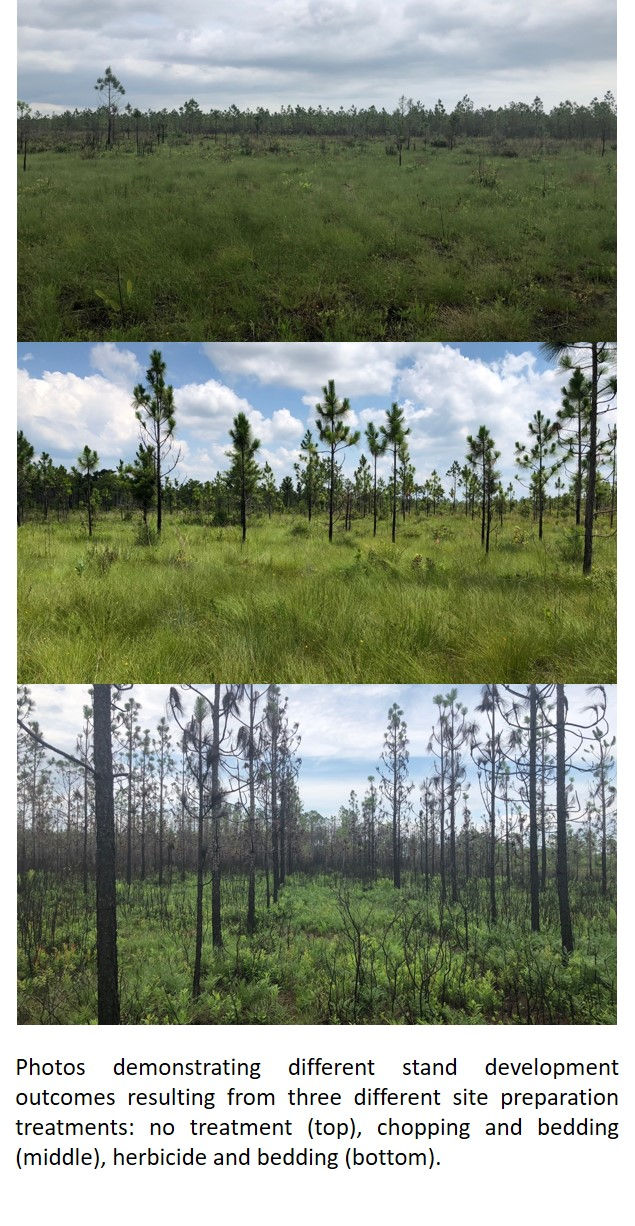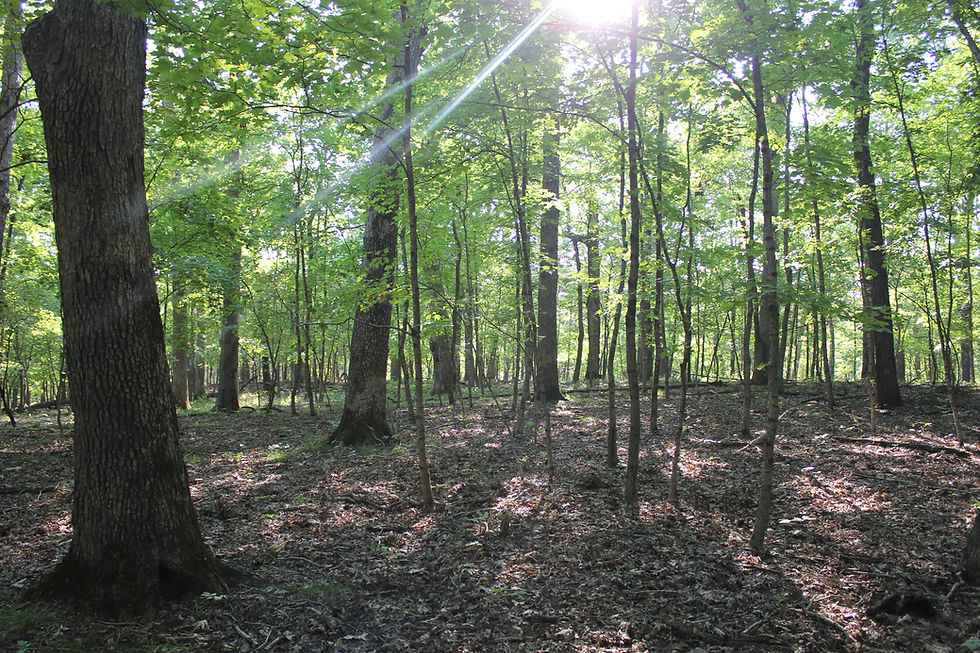New Paper Brief: site preparation for longleaf pine restoration
- Ben Knapp
- May 14, 2020
- 5 min read
Updated: May 18, 2020
**Contributed by guest author Connor Crouch**
“Site preparation for longleaf pine restoration on hydric sites: Stand development through 15 years after planting” – Forest Ecology and Management: Connor Crouch, Benjamin Knapp, Susan Cohen, Michael Stambaugh, Joan Walker, and Geoff Wang

Over two decades ago, land managers on Marine Corps Base Camp Lejeune became interested in restoring longleaf pine on the hydric sites that are common on base. Camp Lejeune, like much of the Southeast, was once dominated by longleaf pine forests, but by the year 2000, longleaf pine had been lost from about 98% of its historic range. This dramatic loss of longleaf pine across the landscape was the result of a number of changes following European settlement including widespread timber harvest and naval stores production, grazing by feral hogs and other livestock, land conversion for urban and agricultural uses, and most importantly fire exclusion.
More than just longleaf pine trees were lost with the reduction of longleaf pine ecosystems. These ecosystems include some of the most diverse plant communities outside of the tropics. Over 400 rare plants are associated with longleaf pine, and one of those – Venus flytrap – is commonly found on Camp Lejeune. Like longleaf pine, Venus flytrap is highly dependent upon frequent fire, and flytrap populations quickly decline when fire return intervals exceed 3 years. Another rare organism associated with longleaf pine is the federally endangered red-cockaded woodpecker, which relies on mature longleaf pine for habitat. This woodpecker has become the poster-bird for longleaf pine restoration, as efforts to restore longleaf pine on federally owned land, like Camp Lejeune, have been motivated by the woodpecker’s listing on the Endangered Species Act.
Although the motivation for longleaf pine restoration was clear, Camp Lejeune’s foresters were unsure how best to re-establish longleaf pine on base. Restoration of longleaf pine often involves planting seedlings because overstory trees are no longer present to provide a seed source for natural regeneration. Planting longleaf pine is challenging, though, because seedlings are intolerant of competition. Re-establishing longleaf pine on Camp Lejeune is especially challenging because hydric, poorly drained sites are common on base. Hydric sites are characterized by abundant shrubs, which compete with planted seedlings, and poor soil drainage, which inhibits growth and survival of seedlings. Site preparation treatments, which are applied prior to planting and are designed to improve seedling establishment outcomes, are a common strategy used to overcome these challenging conditions. Site preparation techniques are regularly used for industrial timber operations in the Southeast, but their potential role in a restoration setting has not been well-studied. We know from a wealth of previous studies that site preparation improves short-term growth and surivival of other southern pine seedlings but information on longleaf pine is scarce. Investment in site preparation assumes that the treatments will result in long-term benefits, and responses of longleaf pine to site preparation through stand development are not well understood.
An additional challenge that Camp Lejeune's foresters faced is that they didn’t only want to restore longleaf pine. In addition to re-establishment of longleaf pine trees, restoration seeks to maintain or even improve the understory plant community that has so much value in these ecosystems. However, there are concerns that the site preparation treatments used to improve seedling establishment may have negative impacts on understory plants. For example, wiregrass is a bunchgrass that once dominated the understory of longleaf savannas on Camp Lejeune and plays an important role in carrying surface fire through longleaf ecosystems. Camp Lejeune’s foresters were worried that intense mechanical site preparation might harm wiregrass populations because the species is very sensitive to soil disturbance. Therefore, the foresters on Camp Lejeune wanted to better understand how site preparation treatments affect both long-term longleaf pine establishment and the understory plant community. This management need provided the basis for our research on long-term overstory and understory responses to site preparation in the context of ecosystem restoration.

In this study, we wanted to understand how various site preparation treatments impact long-term longleaf pine stand development. Results from the second half of this research project – quantifying
understory responses to site preparation – are forthcoming (stay tuned!). Specific to the longleaf pine portion of the project, we studied survival and growth of planted seedlings through three years and at 15 years after application of different site preparation treatments. These treatments included various combinations of chopping, herbicide, bedding, and mounding in addition to an untreated control. We also conducted stem analysis on a subset of trees within each study treatment to explore growth patterns of the trees through time.

We found that site preparation significantly improved long-term growth and survival of longleaf pine. For the two vegetation control treatments that we tested, herbicide resulted in more successful stand establishment outcomes (i.e., growth and survival) than chopping. Among the three soil manipulation treatments we tested, mounding and bedding resulted in similar long-term stand establishment outcomes, and both of these treatments out-performed flat-planting (no soil manipulation). The long-term nature of our study also allowed us to uncover some fascinating findings. We found that relative diameter (a measure of each treatment’s mean diameter relative to the control treatment’s mean diameter) remained extremely consistent from year two to year 15, indicating a sustained long-term benefit to growth obtained from site preparation. In contrast, we found that the study treatments had similar survival through two years after treatment, but by year 15, significant differences existed. Without the long-term measurements, we would have concluded that site preparation does not improve seedling survival (as previous studies have). Instead, the effects of site preparation on survival simply took longer to develop.

Longleaf pine has a unique fire adaptation called the grass stage. After germinating, longleaf pine seedlings remain stemless, leaving only their foot-long needles aboveground and making them look almost like a bunchgrass. This stage can last anywhere from one year to decades, depending upon the amount of competition surrounding the seedling. The grass stage is beneficial because it allows longleaf pine seedlings to survive surface fires better than other species that begin to grow upward immediately after germination. We were curious whether the differences we observed among study treatments might be the result of site preparation promoting earlier emergence from the grass stage or resulting in increased growth after grass stage emergence. Using stem analysis, we learned that differences in stand development among the study treatments were primarily driven by increased longleaf pine growth after grass stage emergence, rather than a shortened amount of time spent in the grass stage.

Perhaps the most important takeaway we learned from this study was that different site preparation treatments can be used to achieve different restoration objectives. For example, one restoration objective could be to restore a longleaf pine savanna, which has relatively open forest structure and low stand density. Our study showed planting about 1,000 longleaf pine seedlings per hectare resulted in about 125 trees per hectare in year 15. Although this is a high degree of mortality and the surviving trees were small, the resulting stand may meet objectives of savanna restoration if the trees continue to grow and survive to maturity. An alternative restoration scenario could be to optimize longleaf pine stand density and growth rates to minimize time required to satisfy red-cockaded woodpecker habitat guidelines. In this scenario, application of herbicide and/or a soil manipulation treatment would improve the long-term survival and growth of planted seedlings, allowing the practitioner to establish suitable woodpecker habitat more quickly.
To fully understand site preparation’s role in longleaf pine restoration, we must know the impact of these treatments on the understory plant community. Ultimately, the goal is to strike a balance between improving longleaf pine establishment and minimizing negative impacts on the understory plant community. Our future work seeks to address these trade-offs and provide a more holistic picture of how site preparation can be used to restore longleaf pine ecosystems, both on Camp Lejeune and on similar hydric sites throughout the Southeast.
























Comments